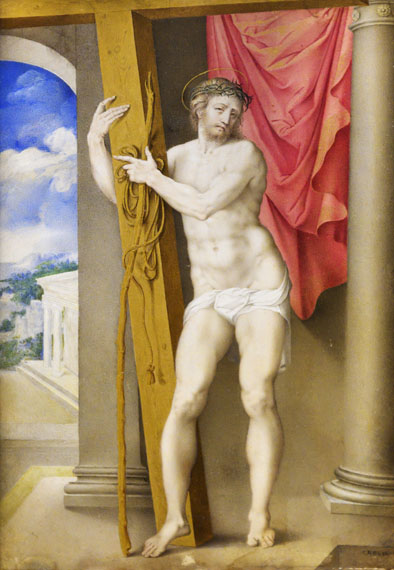Pilar Conde donates a Giulio Clovio
Pilar Conde Gutierrez del Alamo, an art collector of the United States originally from Spain, has generously donated Risen Christ by Giulio Clovio to American Friends of the Prado Museum. The exquisite and delicate work, signed by the artist, employs the technique of gouache and watercolor, heightened with gold, on vellum and was performed between the 1550s and 1570s.
Giulio Clovio (Grižane, Croatia, 1498-Rome, 1578), considered the best illuminator of the Renaissance, carried out his artistic career in Italy, primarily in Rome at the service of Cardinal Alessandro Farnese. Throughout his life he came into contact with some of the greatest artists of the time such as Michelangelo, Rafael Sanzio and Giulio Romano with whom he furthered his artistic education.
For the Risen Christ the artist used Michelangelo's sculpture of the same name, conserved in Santa Maria sopra Minerva in Rome, as inspiration for the composition.
Giulio Clovio (Grižane, Croatia, 1498-Rome, 1578), considered the best illuminator of the Renaissance, carried out his artistic career in Italy, primarily in Rome at the service of Cardinal Alessandro Farnese. Throughout his life he came into contact with some of the greatest artists of the time such as Michelangelo, Rafael Sanzio and Giulio Romano with whom he furthered his artistic education.
For the Risen Christ the artist used Michelangelo's sculpture of the same name, conserved in Santa Maria sopra Minerva in Rome, as inspiration for the composition.
Clovio specialized in illuminated manuscripts and greatly innovated by converting the technique into independent small format paintings. His style is very influenced by his contemporaries, particularly Michelangelo and Rafael, and moves towards mannerism - visible in his choice of colors, the tendency to distort the human figure and the use of unreal perspectives.
King Philip II of Spain possessed various works by Clovio, who was already admired from the time of his father Charles V, both by the monarchs and the members of their court. However, after Napoleon and the Peninsular War, they ended up in French collections.
Pilar Conde, pleased to have reconnected this work to the Prado, comments: “I felt I should donate the work to American Friends of the Prado Museum for the enjoyment of the visitors to the Museum and I hope when the public comes to see the work by Clovio they will enjoy it as much as I have.”
King Philip II of Spain possessed various works by Clovio, who was already admired from the time of his father Charles V, both by the monarchs and the members of their court. However, after Napoleon and the Peninsular War, they ended up in French collections.
Pilar Conde, pleased to have reconnected this work to the Prado, comments: “I felt I should donate the work to American Friends of the Prado Museum for the enjoyment of the visitors to the Museum and I hope when the public comes to see the work by Clovio they will enjoy it as much as I have.”


